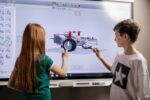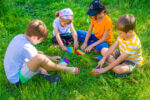Every child has creative potential. Nurturing this through arts education allows expression, connection, and skill-building that is essential for your child’s academic journey and future career success. Studies show that arts education benefits extend beyond creativity, leading to fewer disciplinary issues, improved writing, increased college aspirations, and greater academic engagement. Here’s how:
Develop Fine Motor Skills
As your child grips crayons or markers and focuses on coloring within the lines, they strengthen the muscles in their fingers and improve hand-eye coordination, dexterity, and precision. These early artistic activities prepare them for learning to write, making art a fun way to develop fine motor skills.
Boost Critical Thinking, Creativity, and Problem-Solving Skills
Arts education encourages students to think outside the box and flex their creativity. These skills combined—critical thinking and creative problem-solving—are essential throughout school and any career.
Build Social Emotional Skills
Participation in the arts helps develop social skills and emotional regulation. It encourages positive behaviors like sharing, caring, helping, and showing empathy. Music-based activities, such as singing to your children, can significantly boost these social skills and positive behaviors.
Improve Expression and Communication
Your student can use the arts as a safe space for self-expression. Whatever art form they choose, it offers an effective way to communicate emotions and messages while fostering conversation and collaboration.
Increase Focus and Patience
Whether performing a dance, delivering a monologue, playing the violin, or creating a sculpture, arts education requires concentration and patience. Your child will learn to focus, block out distractions, and pay attention to details.
Advanced Learners and the Arts
Arts education is particularly beneficial for gifted and advanced learners when integrated into an interdisciplinary curriculum. It helps students make meaningful connections across subjects, leading to a better understanding and expression of complex concepts.
How to Engage in the Arts Outside of School
Arts education programs may not always be prioritized in school funding, but your child can still engage in the arts outside the classroom:
- Visit local or virtual art museums. (Check out the Louvre or The National Gallery.)
- Audition for a role in a local community theater.
- Take up a musical instrument.
- Attend live music or theater performances in your town.
- Work on fun crafts together or sculpt with clay.
- Get inspired by nature—take a sketch pad outdoors.
- Submit creations to art competitions.
If your child loves art and their school doesn’t offer sufficient courses, consider online schools like those powered by K12. Students can explore digital design, sculpting, photography, fashion, culinary arts, and more while learning the principles and history of art in a flexible learning environment.






























































































